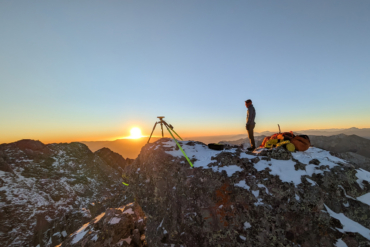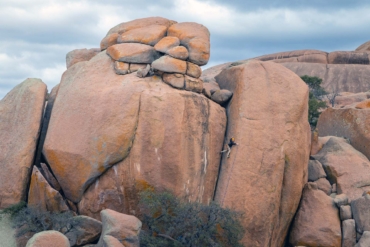Check out our recent interview with Steph Davis for the scoop on the best innovations in climbing over the years, her favorite gear, when you can climb with her, and more.
There’s nothing quite like nerding out on gear with one of the most popular climbers of all time. This past week, we got a chance to Zoom call with professional climber Steph Davis to talk all things climbing: ropes, shoes, draws, and more.
Wondering what her go-to crag pack is? Maybe how climbing gear has changed since those early Yosemite days? What about her advice for new climbers?
We’ve got all that and more.
Steph Davis Q&A

GearJunkie: You’ve been climbing since the ’90s. What has been the most significant evolution in gear you’ve seen in the past 20 years?
Steph Davis: Oh gosh, there’s so many. I’d say the best evolution in gear has been the combination of lightweight and durability. That’s like the Holy Grail for climbing equipment — and very difficult [to get].
When things were heavy, it was when the materials weren’t yet there, or you needed it for safety, so a lot of times, the weight had to be there. People have been pushing to get that lighter, but there’s a tradeoff with durability and longevity.
Sometimes you are willing to make that tradeoff. But as material and construction methods have improved, I think that’s the biggest thing I’ve seen now. Light and durable, and safe.
With current gear, one place I find this has really manifested is with quickdraws. Mammut came out with the Sender draws recently, and I just lost my mind. They are adequate sport climbing quickdraws, and they handle well, they are the right size … and they weigh nothing.
GJ: Have ropes changed as well?
I remember when I started climbing, people were using 11mm as their normal lead rope; it was crazy. To see these ropes getting lighter and thinner, but also having that hefty — maybe that isn’t the right word — having that still substantial texture. It’s so cool.
And there will still be times when I take a heavier rope, maybe someone’s jumaring on it, or there’s loose rock where you’re going, but still — heavier ropes nowadays are still very light. It’s lighter, and it’s trustworthy.
GJ: Last year, we saw the first 100% recycled weave rope. How big was that for the climbing world?
So, now brands are taking all these pieces that they would normally throw away, and they are using all of that to make a rope. So, the sheath ends up being multicolored, not “this is a blue rope.” There’s a big sustainability push that’s going on, too, for sure.
GJ: How about dry-treated ropes? Was there a time when that was a huge deal for ropes?
I can’t remember when that started, but I’d be really curious to know. I mean, for alpine climbing, you always wanted dry … it lasts longer, doesn’t get wet, it’s nicer anyway. But I’d really be curious when that started.
Another thing that was big for me was bi-colored ropes, so with a split pattern [on one half]. That was a huge evolution. I remember when I first got a rope like that. It’s common now, but initially, it was a big thing.
GJ: You’ve had different sponsors over the years. At the time, did any gear that you tested ahead of its time stick out?
So, it’s funny when I first started working with Mammut; I think it was in 2003. The reason I started working with them is because they were making the Contact sling. And back then, it was new.
So, the light slings at the time were like the shoulder slings that are part nylon, part Dyneema, and slightly wider. And these new Contact slings were a fraction of that thickness because almost the whole thing was Dyneema.
And that was a game-changer in terms of weight. I had heard about it at a tradeshow and went over and said, “I want one of these!”
GJ: How about climbing shoes?
I think people were already doing some down-turning of shoes when I started climbing, but it’s definitely been more in the past few decades. I think that’s been significant. There’s a time and place for flat shoes, obviously, but overall, shoes can change the way you climb.
I am a huge slippers wearer for climbing in the desert [crack climbing]. Otherwise, Velcro shoes for sport climbing. I don’t like anything that takes time, like laces.
GJ: Is there something sentimental that remains in your kit from when you first started climbing?
When I first started climbing, everybody used a gear sling. Since things have gotten so more specific (like only bouldering, people starting in gyms) … along the way, I think people lost the concept of using a gear sling. They would just put it on their harness.
And there are a lot of situations where you don’t want all that gear on your hips, like cams pressing into your thighs while you’re climbing a dihedral — ridiculous.
Anyways, when I started climbing in the ’90s, there was a gear sling, and you’d pass it back and forth. I was climbing with guys, so it was always long, caught between my legs … I hated it.
So, one day, I was in the Yosemite climbing shop, and I saw an ABC-brand gear sling, and it had sizes. And I was like, “What?!” So I bought a small one, and it changed my life because suddenly, my gear wasn’t in my crotch.
Then I started making my own, smaller and smaller sizes. Now, when we trade pitches, you have your gear sling, and I have mine.
And I still have that one. Very simple, fleece padding, one-inch webbing. I didn’t think much of it, but I teach these climbing clinics, and I started recommending them.
Teaching people about racking, telling people to make sure the gear sling is their size … and people would email me after saying, “I can’t find a gear sling!”
So, I started researching, and I guess nobody was making gear slings anymore. I thought, I guess I have to make these available because people need a damn gear sling. I have a buddy who sews gear and makes portaledges who helped me make them, and that way, I can provide them to people.
I actually sell them on my website, just for people who may need them. I’d say once a month, I get an order from someone who finds it.
But that was the goal. I just want people to have gear slings!
GJ: What about having women’s-specific gear is important to you?
Helmets that now come in smaller sizes — that’s important. And also clothing. Climbing clothing used to be few and far between, so now, having clothing that fits correctly that’s huge.
I think we went through this evolution: first, we got women’s clothing, then there was this transition that had to happen from standard women’s fit to women’s athlete fit. I think there’s a difference there. So, body shape … for example, many trail runners don’t have a waist.
So, the stereotypical pants with a tiny waist and wide hips don’t work. And the same goes for problems with shoulders: with broader shoulders, we need it to fit differently.
The fit models have changed: it’s not just that we are female, but that we do all these different sports.
Steph Davis’ Go-To Climbing Kit
- Mammut 9.0 Crag Sender Rope
- Mammut Neon Gear Crag Pack
- Mammut Nordwand Harness
- Mammut Workhorse Quickdraws and Sender Quickdraws
- Mammut Wall Rider MIPS Helmet
- Mammut Aenergy Light Jacket
Wondering what Steph Davis is up to now? Still climbing, of course, but she’s also sharing her climbing knowledge. And you could get the chance to climb with her! Davis’ climbing clinics are in the spring and fall each year, and registration is open now.
- Indian Creek Crack Clinic, April 23-25, 2023
- Moab Women’s Clinic, May 7-9, 2023
Mammut is Davis’ longest-running sponsor over the years — she’s been using and testing gear with Mammut since 2004. Davis’ current sponsors include: Evolv, Osprey, Kavu, Gnarly Nutrition, and Nulo Petfood. In prior years, Steph Davis was sponsored by Patagonia, Five Ten, and Black Diamond.











